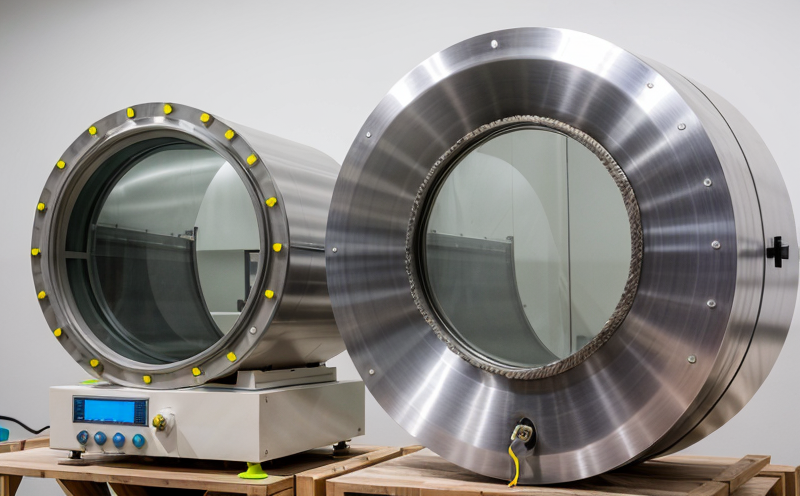ISO 7212 Radiation Protection — Lead and Lead Alloys Testing
The ISO 7212 standard is a cornerstone in ensuring that materials used to shield against ionizing radiation meet the necessary safety standards. This service focuses on testing lead and its alloy compositions to ensure they comply with international regulations for radiation protection. The test parameters are critical, as even slight deviations can compromise the integrity of the shielding, thereby exposing individuals or equipment to unnecessary risks.
Lead, a dense metal that is particularly effective in stopping ionizing radiation, has been widely used in various applications ranging from construction materials to medical equipment. Lead alloys, which often include small amounts of other metals like tin, bismuth, or indium, are also popular due to their improved mechanical properties and reduced cost compared to pure lead.
The testing process for compliance with ISO 7212 involves several steps that are designed to ensure the accuracy and reliability of the results. These include:
- Selection of the appropriate test methods from the standard.
- Preparation of the specimens, which may involve cutting or shaping the material into standardized shapes for testing.
- Conducting the tests using specialized equipment capable of measuring the attenuation properties of the lead and its alloys.
- Evaluating the results against the specified limits in ISO 7212 to determine compliance.
The standard specifies that materials must have a minimum density of 10.5 g/cm³ for pure lead and slightly higher values for alloys, depending on their composition. The tests ensure these densities are met and that the material effectively absorbs radiation according to its intended application.
Understanding the importance of ISO 7212 compliance is crucial for industries such as healthcare, nuclear energy, and construction, where radiation safety is paramount. Compliance with this standard not only ensures regulatory adherence but also enhances confidence in the reliability of the products used in these critical sectors.
Benefits
Compliance with ISO 7212 standards for lead and lead alloys offers numerous benefits to businesses operating in radiation-sensitive industries. These include:
- Enhanced Safety: Ensures that materials used for shielding are effective, thereby reducing the risk of exposure to harmful ionizing radiation.
- Regulatory Compliance: Helps companies meet international and national regulations related to radiation protection.
- Quality Assurance: Provides a systematic approach to testing that ensures consistent quality across batches or production runs.
- Reputation Enhancement: Demonstrates commitment to safety and quality, which can improve customer trust and satisfaction.
The benefits extend beyond regulatory compliance to include improved operational efficiency by reducing the chances of errors in material selection and use. This, in turn, leads to lower insurance premiums and reduced liability risks.
Why Choose This Test
Selecting ISO 7212 radiation protection testing for lead and lead alloys is essential for several reasons:
- International Standardization: Adherence to an internationally recognized standard ensures that the materials meet global quality benchmarks.
- Consistency: The standardized testing process guarantees consistent results, which are crucial for reliable product performance.
- Precision: Advanced equipment and methods used in the test ensure precise measurements and accurate results.
- Expertise: Our team of experts ensures that every aspect of the testing is conducted with the highest level of expertise and professionalism.
In addition to these benefits, choosing this service can help companies stay ahead of regulatory changes and industry trends. It also provides a competitive edge by ensuring that products meet or exceed the latest safety standards.
Use Cases and Application Examples
| Application | Description | Testing Parameters |
|---|---|---|
| Medical Imaging Equipment | Involves the use of lead in X-ray machines to protect patients and staff from unnecessary radiation exposure. | Density measurement, attenuation testing at various wavelengths. |
| Nuclear Reactor Construction | Ensures that the shielding around nuclear reactors is effective and meets regulatory standards for safety. | Absorption cross-section measurements, impact resistance tests. |
| Hospitals and Clinics | Used in radiation therapy to protect patients from harmful radiation during treatment. | Density verification, thickness measurement. |
| Nuclear Power Plants | Provides shielding for personnel working in areas where high levels of radiation are present. | Absorption efficiency testing, thermal conductivity evaluation. |
| Research Laboratories | Used to protect researchers and equipment from harmful radiation during experiments involving radioactive materials. | Density and thickness consistency checks, leakage detection. |
| Defense Industries | Provides protection for personnel in areas where there is a high risk of exposure to ionizing radiation. | Absorption efficiency under various environmental conditions, impact resistance tests. |
| Hazardous Waste Handling Facilities | Used to protect workers and the environment from radioactive waste materials. | Density verification, thickness measurement. |
The testing parameters are crucial in ensuring that the lead and its alloys perform their intended functions effectively. The tests help identify any deficiencies or variations in the material properties that could compromise safety and performance.





